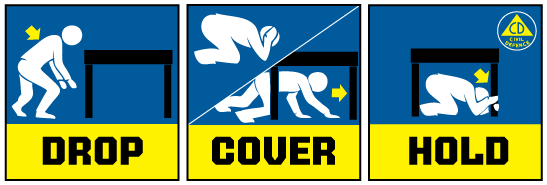It is important for all New Zealanders to know about geohazards and what to do if one occurs. Find out about the area where you live and what the local hazards are. Make an emergency plan with your family. Put a survival kit together and update it often.
Volcanic eruptions
- Save water in your bath, basin or containers - water supplies may become polluted.
- Stay indoors with your pets.
- Wear mask and goggles if you go outside, to keep volcanic ash out of your eyes and lungs.
- Keep gutters and roof clear of ash – thick layers of ash can collapse the roof.
- Take your outdoor clothing off before entering a building – volcanic ash is difficult to get rid of.
- Take your Getaway Kit with you if you have to leave. Turn electricity and gas off at the mains.
- Don’t go sightseeing.
- Don’t leave home unless advised to by Civil Defence.
After eruptions
Buildings
- Do not let ash build up. Volcanic ash is heavy and could cause damage to roofs and guttering.
- Light ash falls can also set in gutters and downpipes and cause problems.
- Use a broom to sweep the ash off.
- Try to stop ash getting into storm-water drains.
Furniture and Glass
- Ash can scratch items. If possible, clean with a vacuum cleaner.
- Otherwise clean by using a dusting or dabbing motion, not by wiping, which will cause scratches. Use a detergent-soaked cloth to clean glass surfaces.
Motor Vehicles
- If possible, get motor vehicles under cover or cover the vehicle with a sheet.
- Do not use wipers to clear ash off car windscreens - dust off with a brush. Keep car windows closed.
- Wash car gently with warm water and detergent, rinse with cold water and gently towel dry.
- In heavy ash fall do not use air vents or air conditioning.
Electrical Appliances
- Ash can cause short circuits. Do not use appliances outside during ash fall. Turn off those affected and clean, inside and out, with a vacuum cleaner or duster.
How to prepare for an earthquake
EQC advises people about how to Quake Safe their homes: Talk to parents/caregivers about the following list of things to make your house 'quake safe'.
- Check that your house is secured to its foundations
- Secure hot water cylinders and header tanks
- Secure your chimney or replace it with a lightweight replica
- Secure tall furniture to the wall studs
- Attach wood burners to the floor
- Store heavy objects low down
- Use non-slip mats under smaller appliances and objects
- Use plastic putty (Blu Tack) to secure ornaments
- Push picture and mirror hooks closed
- Check your household insurance cover
During an earthquake
- Move no more than a few steps to a safe place, drop, cover and hold on.
- Do not run outside.
- If outside, move no more than a few steps to a safe place, then drop, cover and hold.
- If in a lift, stop at the nearest floor and get out.
- If you are in a car, the driver should pull over to the side of the road. Stay in the car until the shaking stops.
- If you are near the coast, drop, cover and hold during an earthquake, then move quickly to higher ground when the shaking stops.

After an earthquake
- Expect aftershocks and help those around you if you can.
- Report injuries or fires to the emergency services (dial 111).
- Put out small fires and leave the building if the fires cannot be controlled.
- Turn off gas and electricity.
- Listen to the radio for advice and information.
- Do not go sightseeing and stay out of damaged buildings.
Landslides
If a landslide occurs in your area, leave straight away. Do not return to your home until you are told it is safe.
Tsunami
If you live on the coast and you feel an earthquake that lasts longer than a minute, or is so strong that it is difficult to stand up, then you should move to higher ground immediately. Also, if you are at the beach and see the water quickly recede, move to higher ground. You may have only a few minutes before a tsunami arrives.
If the tsunami is coming from a long way off, then you probably will not feel an earthquake but warnings will be given over the radio. You may have over ten hours to get ready to leave the area.











